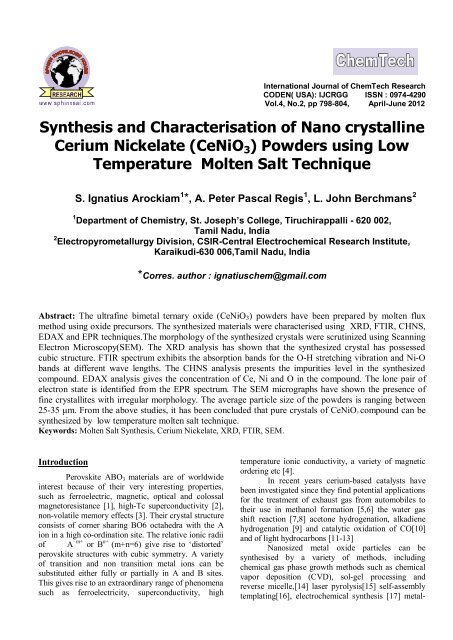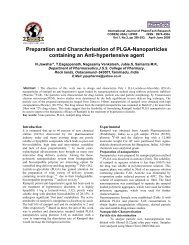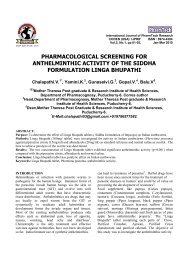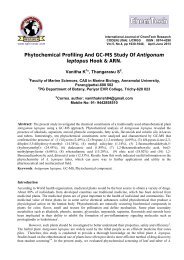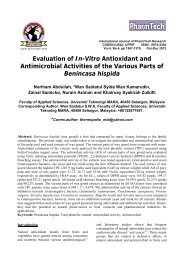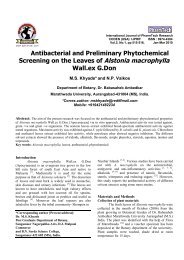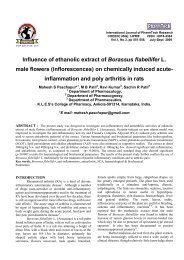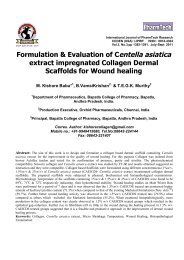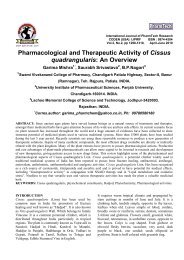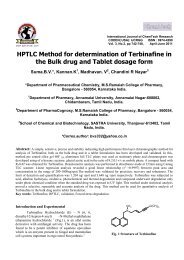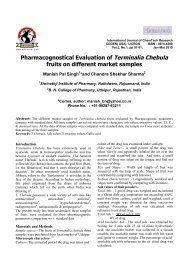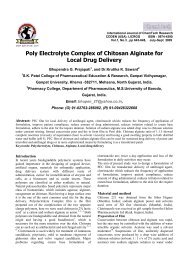Synthesis and Characterisation of Nano crystalline Cerium Nickelate ...
Synthesis and Characterisation of Nano crystalline Cerium Nickelate ...
Synthesis and Characterisation of Nano crystalline Cerium Nickelate ...
You also want an ePaper? Increase the reach of your titles
YUMPU automatically turns print PDFs into web optimized ePapers that Google loves.
International Journal <strong>of</strong> ChemTech Research<br />
CODEN( USA): IJCRGG ISSN : 0974-4290<br />
Vol.4, No.2, pp 798-804, April-June 2012<br />
<strong>Synthesis</strong> <strong>and</strong> <strong>Characterisation</strong> <strong>of</strong> <strong>Nano</strong> <strong>crystalline</strong><br />
<strong>Cerium</strong> <strong>Nickelate</strong> (CeNiO3) Powders using Low<br />
Temperature Molten Salt Technique<br />
S. Ignatius Arockiam 1 *, A. Peter Pascal Regis 1 , L. John Berchmans 2<br />
1 Department <strong>of</strong> Chemistry, St. Joseph’s College, Tiruchirappalli - 620 002,<br />
Tamil Nadu, India<br />
2 Electropyrometallurgy Division, CSIR-Central Electrochemical Research Institute,<br />
Karaikudi-630 006,Tamil Nadu, India<br />
*Corres. author : ignatiuschem@gmail.com<br />
Abstract: The ultrafine bimetal ternary oxide (CeNiO3) powders have been prepared by molten flux<br />
method using oxide precursors. The synthesized materials were characterised using XRD, FTIR, CHNS,<br />
EDAX <strong>and</strong> EPR techniques.The morphology <strong>of</strong> the synthesized crystals were scrutinized using Scanning<br />
Electron Microscopy(SEM). The XRD analysis has shown that the synthesized crystal has possessed<br />
cubic structure. FTIR spectrum exhibits the absorption b<strong>and</strong>s for the O-H stretching vibration <strong>and</strong> Ni-O<br />
b<strong>and</strong>s at different wave lengths. The CHNS analysis presents the impurities level in the synthesized<br />
compound. EDAX analysis gives the concentration <strong>of</strong> Ce, Ni <strong>and</strong> O in the compound. The lone pair <strong>of</strong><br />
electron state is identified from the EPR spectrum. The SEM micrographs have shown the presence <strong>of</strong><br />
fine crystallites with irregular morphology. The average particle size <strong>of</strong> the powders is ranging between<br />
25-35 μm. From the above studies, it has been concluded that pure crystals <strong>of</strong> CeNiO3 compound can be<br />
synthesized by low temperature molten salt technique.<br />
Keywords: Molten Salt <strong>Synthesis</strong>, <strong>Cerium</strong> <strong>Nickelate</strong>, XRD, FTIR, SEM.<br />
Introduction<br />
Perovskite ABO3 materials are <strong>of</strong> worldwide<br />
interest because <strong>of</strong> their very interesting properties,<br />
such as ferroelectric, magnetic, optical <strong>and</strong> colossal<br />
magnetoresistance [1], high-Tc superconductivity [2],<br />
non-volatile memory effects [3]. Their crystal structure<br />
consists <strong>of</strong> corner sharing BO6 octahedra with the A<br />
ion in a high co-ordination site. The relative ionic radii<br />
<strong>of</strong> A m+ or B n+ (m+n=6) give rise to ‘distorted’<br />
perovskite structures with cubic symmetry. A variety<br />
<strong>of</strong> transition <strong>and</strong> non transition metal ions can be<br />
substituted either fully or partially in A <strong>and</strong> B sites.<br />
This gives rise to an extraordinary range <strong>of</strong> phenomena<br />
such as ferroelectricity, superconductivity, high<br />
temperature ionic conductivity, a variety <strong>of</strong> magnetic<br />
ordering etc [4].<br />
In recent years cerium-based catalysts have<br />
been investigated since they find potential applications<br />
for the treatment <strong>of</strong> exhaust gas from automobiles to<br />
their use in methanol formation [5,6] the water gas<br />
shift reaction [7,8] acetone hydrogenation, alkadiene<br />
hydrogenation [9] <strong>and</strong> catalytic oxidation <strong>of</strong> CO[10]<br />
<strong>and</strong> <strong>of</strong> light hydrocarbons [11-13]<br />
<strong>Nano</strong>sized metal oxide particles can be<br />
synthesised by a variety <strong>of</strong> methods, including<br />
chemical gas phase growth methods such as chemical<br />
vapor deposition (CVD), sol-gel processing <strong>and</strong><br />
reverse micelle,[14] laser pyrolysis[15] self-assembly<br />
templating[16], electrochemical synthesis [17] metal-
S.Ignatius Arockiam et al /Int.J. ChemTech Res.2012,4(2) 799<br />
organic chemical vapor deposition (MOCVD),<br />
molecular beam epitaxial, <strong>and</strong> plasma synthesis<br />
[18,19]. Molten salt synthesis is one <strong>of</strong> the most<br />
versatile techniques to prepare highly ordered complex<br />
oxide materials. The molten salts are used as the<br />
reaction medium for the reactants dissolution <strong>and</strong><br />
product precipitation. Studies have shown that the<br />
products obtained from molten salts are affected by the<br />
synthesis conditions, such as the type <strong>of</strong> salt used, the<br />
annealing temperature, the temperature ramp rate, the<br />
precursor composition, <strong>and</strong> the solubility <strong>of</strong> the<br />
reactive constituents in the molten salt etc, [20-22 ].<br />
The molten salts rendered homogeneous<br />
distribution <strong>and</strong> high intimacy <strong>of</strong> the reactive<br />
components at the atomic scale in the initial mixture <strong>of</strong><br />
precursor salts. Hence, the diffusion distance <strong>and</strong> the<br />
rate <strong>of</strong> the reactive species in molten melts are<br />
modified <strong>and</strong> an efficient material transport is enabled<br />
to meet the minimal kinetic requirement for the<br />
reaction [23-25].<br />
Generally the starting materials for molten salt<br />
synthesis are inorganic compounds such as sulfates,<br />
chlorides <strong>and</strong> oxides, which are blended with the alkali<br />
metal nitrates, chlorides, carbonates, hydroxides as a<br />
powder mixture before heating to the reaction<br />
temperature. Many complex oxide materials have been<br />
synthesized by molten salt technique [26-29].<br />
Even though, many s<strong>of</strong>t chemical routes have been<br />
attempted, only few studies have been made on the<br />
CeO2<br />
NaCl/KCl Flux<br />
synthesis <strong>of</strong> CeNiO3 compounds using molten flux<br />
method. Hence, an attempt has been made on the<br />
preparation <strong>of</strong> CeNiO3 by this method.<br />
Experimental work<br />
Reagent-grade chemicals like cerium oxide<br />
(CeO2), nickel oxide (NiO) were used as the starting<br />
materials. They were obtained from Merck India Ltd,<br />
Bombay. Appropriate amount <strong>of</strong> chloride salts such as<br />
sodium chloride (NaCl) <strong>and</strong> potassium chloride (KCl)<br />
were used as the flux. They were thoroughly ground<br />
using a mortar <strong>and</strong> pestle <strong>and</strong> were placed in a high<br />
density alumina crucible. The mixture was then heated<br />
in an electrical resistance furnace at 900 0 C for 12 hrs.<br />
The heating rate was 200 °C per hour for all the<br />
experiments.The resulting reaction mixture was cooled<br />
to ambient temperature <strong>and</strong> it was washed with hot<br />
water for several times. The unreacted cerium, nickel,<br />
alkaline salts were removed by treating with these<br />
solvents. The residual powders were dried in a vacuum<br />
oven at 50 °C for 1 hour <strong>and</strong> cooled to room<br />
temperature. The method <strong>of</strong> synthesis is presented in<br />
the form <strong>of</strong> a flow chart <strong>and</strong> shown in fig.1. Finally<br />
free flowing fine powders were obtained <strong>and</strong> they were<br />
characterized for their physicochemical properties.<br />
Mixed <strong>and</strong> placed in Alumina crucible<br />
Thermal treatment at 900 0 C<br />
Washing with hot water<br />
Dyring in hot air oven<br />
Fine <strong>crystalline</strong> CeNiO3<br />
Fig-1: Flow chart for the preparation <strong>of</strong> CeNiO3 compound.<br />
NiO
S.Ignatius Arockiam et al /Int.J. ChemTech Res.2012,4(2) 800<br />
The purified powders were characterized by<br />
XRD (Philips 8030 X-ray diffractometer) to identify<br />
the phase purity <strong>of</strong> the compound. The unit cell lattice<br />
parameters were obtained by the Least-square fitting<br />
method <strong>of</strong> the d-spacing <strong>and</strong> the hkl values. Fourier<br />
transform infrared (FTIR) Spectroscopy was used to<br />
study the structure coordination <strong>of</strong> the calcined<br />
powders using Perkin Elmer UK paragon-500<br />
spectrophotometer. To record the spectrum, each<br />
sample was mixed with KBr, ground in to fine powder<br />
<strong>and</strong> made into pellet. It was then examined in the<br />
wave number ranging from 400-4000 cm−1. The<br />
elemental composition <strong>of</strong> the synthesized powders was<br />
determined using an Atomic absorption spectroscope<br />
(AAS) Varian Spectra 220 spectrophotometer. Carbon,<br />
hydrogen, nitrogen, <strong>and</strong> sulphur contents <strong>of</strong> the<br />
samples were assessed using an Elemental analyzer<br />
Vario EL III-Germany Instrument. Electron spin<br />
resonance (ESR) spectral analysis was performed<br />
using microwave frequency 9.857403 GHz with fields<br />
corresponding to about ~ 6500.000G sweep width<br />
using a Bruker Bio Spin Gmbh EPR spectrometer. The<br />
morphology <strong>of</strong> the synthesized powders was examined<br />
by a Scanning Electron Microscope (SEM)-JSM-3.5<br />
CF, Japan JEOL make.<br />
counts<br />
12000<br />
10000<br />
8000<br />
6000<br />
4000<br />
2000<br />
0<br />
28.62<br />
33.14<br />
37.32<br />
43.36<br />
47.56<br />
56.4<br />
62.9 69.48<br />
20 30 40 50<br />
Position (2Q)<br />
60 70 80 90<br />
Fig.2 : X-ray diffraction pr<strong>of</strong>ile <strong>of</strong> the CeNiO3<br />
Results <strong>and</strong> Discussion<br />
X-Ray Diffraction studies<br />
The XRD data <strong>of</strong> the synthesized crystals are<br />
presented in Fig.2. The lattice constant values are<br />
determined using the equation,<br />
1/d 2 = h 2 +k 2 +l 2 /a 2<br />
All the XRD peaks are indexed assuming a<br />
cubic structure. The calculated lattice<br />
parameter values are in good agreement with the<br />
reported values. The d spacing values <strong>of</strong> calcined<br />
powders are well matched with the XRD pattern <strong>of</strong><br />
CeNiO3. The average crystallite size <strong>of</strong> the products<br />
was determined from the XRD patterns according to<br />
the Scherrer’s equation D = 0.9λ / βcosθ. The average<br />
crystallite size is ranging between 85-100nm.<br />
Fourier transform infrared (FTIR) spectroscopical<br />
analysis<br />
FTIR spectrum recorded for the cerium<br />
nickelate compound <strong>and</strong> presented in Fig-3. The<br />
transmittance b<strong>and</strong> appeared at 3434 cm -1 may be<br />
attributed to the O-H stretching vibration <strong>of</strong> water<br />
molecules as reported in the literature [30]. The b<strong>and</strong>s<br />
seen between 1456 to 1639 cm -1 are related to the<br />
coordination <strong>of</strong> the Ni 3+ cations as reported by Fernades<br />
et al. [31].The transmittance b<strong>and</strong>s in the wave length<br />
region <strong>of</strong> 3434-3404 cm -1 are responsible for the<br />
formation <strong>of</strong> the single phase CeNiO3compound. The<br />
b<strong>and</strong>s noticed at higher wavelength region may be<br />
assigned to the Ni-O b<strong>and</strong>s.
S.Ignatius Arockiam et al /Int.J. ChemTech Res.2012,4(2) 801<br />
Transmittance [%]<br />
20 40 60 80 100<br />
3912.21<br />
3743.13<br />
3500<br />
3434.58<br />
3500<br />
3000<br />
3000<br />
2924.76<br />
2857.15<br />
2500<br />
2500<br />
2000<br />
2000<br />
Wavenumber cm-1<br />
Fig-3 FTIR spectrum <strong>of</strong> CeNiO3 compund.<br />
Carbon, hydrogen, nitrogen <strong>and</strong> sulfur (CHNS)<br />
analysis<br />
The results on the CHNS analysis are<br />
presented in Table.1. From the table, it is noticed that<br />
the compound has associated with some minor<br />
impurities such as C, H <strong>and</strong> S.<br />
Table 1: Chemical analysis <strong>of</strong> the compound <strong>of</strong><br />
CeNiO3.<br />
compound C (%) H (%) N (%) S (%)<br />
CeNiO3 0.045 0.195 0.000 0.040<br />
Table.2: EDAX analysis data<br />
1736.09<br />
1639.80<br />
1500<br />
1456.75<br />
1500<br />
1162.18<br />
1000<br />
1000<br />
727.53<br />
500<br />
536.53<br />
458.49<br />
500<br />
20 40 60 80 100<br />
Energy dispersive X-ray analysis (EDAX)<br />
The elemental analysis <strong>of</strong> the synthesized<br />
compound was performed using energy dispersive xray<br />
analysis technique . Fig.4. represents the EDAX<br />
pr<strong>of</strong>ile <strong>of</strong> Ce, Ni <strong>and</strong> O <strong>of</strong> the synthesized CeNiO3<br />
compound. The results on the EDAX analysis are<br />
presented in Table.2. The spectrum exhibits the<br />
constituent elements are in appropriate wt%.<br />
Compound Ce (wt%) Ni (wt%) O (wt%)<br />
CeNiO3 60.09 27.51 12.41
S.Ignatius Arockiam et al /Int.J. ChemTech Res.2012,4(2) 802<br />
Fig-4 EDAX pr<strong>of</strong>ile <strong>of</strong> Ce, Ni, <strong>and</strong> O in CeNiO3<br />
Electro paramagnetic resonance (EPR) studies<br />
The paramagnetic resonance spectrum <strong>of</strong> the<br />
CeNiO3 is presented in Fig.5. From the EPR spectrum,<br />
it is noticed that the value <strong>of</strong> g factor is g=2, which<br />
represents the paramagnetic entities present in the<br />
parent compound. The lone pair electron state is<br />
identified from the spectrum. It is also revealed that<br />
the position <strong>of</strong> the signal is very close to the value<br />
expected for uncorrelated spins with the gyromagnetic<br />
factor Ce 4+ - Ni 2+ dipolar interactions.<br />
Intensity<br />
0.2<br />
0.0<br />
-0.2<br />
-0.4<br />
-0.6<br />
-0.8<br />
-1.0<br />
0 1 2 3 4 5 6 7 8 9 10 11 12 13 14<br />
g- factor<br />
Fig-5 EPR spectrum <strong>of</strong> CeNiO3compound<br />
Ultra-violet spectroscopic studies<br />
Fig. 6. shows the UV-Visible spectrum <strong>of</strong> the<br />
synthesized CeNiO3 compound. A broad absorption<br />
b<strong>and</strong> is noticed at 390 nm in the spectrum represents<br />
the Ni-O <strong>and</strong> Ce-O absorption b<strong>and</strong>s. From the<br />
spectrum, the b<strong>and</strong> gap <strong>of</strong> the material is determined<br />
using the formula E = hʋ <strong>and</strong> found to be 3.18 eV.
S.Ignatius Arockiam et al /Int.J. ChemTech Res.2012,4(2) 803<br />
R (%)<br />
1.2<br />
1.1<br />
1.0<br />
0.9<br />
0.8<br />
0.7<br />
0.6<br />
0.5<br />
0.4<br />
200 300 400 500 600 700 800<br />
Wavelength (nm)<br />
Fig-6 UV-Visible spectrum for CeNiO3 compound<br />
SEM analysis<br />
The morphological features <strong>of</strong> the synthesised powders<br />
were obtained by means <strong>of</strong> scanning electron<br />
microscopy. Fig-7(a) <strong>and</strong> 7(b) show the scanning<br />
electron micrographs <strong>of</strong> CeNiO3 compound obtained<br />
Fig- 7(a) <strong>and</strong> 7(b) SEM image <strong>of</strong> CeNiO3<br />
(a) (b)<br />
by Molten Salt <strong>Synthesis</strong> (MSS) route. The crystals<br />
have shown an assorted particle morphology. The<br />
average particle size <strong>of</strong> the powders is ranging<br />
between 25-35 μm.
S.Ignatius Arockiam et al /Int.J. ChemTech Res.2012,4(2) 804<br />
Conclusions<br />
Fine <strong>crystalline</strong> CeNiO3 powders are<br />
successfully synthesized using low temperature molten<br />
salt technique. The XRD analysis confirms that the<br />
compound has the cubic structure. FTIR spectrum<br />
reveals the Ce-O, Ni-O b<strong>and</strong> positions in CeNiO3<br />
compound. CHNS analysis shows the compound has<br />
minor impurities such as carbon, hydrogen <strong>and</strong><br />
sulphur. From the UV reflectance spectrum, the b<strong>and</strong><br />
References<br />
[1] F. Damay, N. Nguyen, A. Maignan, M. Hervieu, B.<br />
Raveau,Solid State Commun. 98 (1996) 997.<br />
[2] Th. Lagouri, Sp. Dedoussis, M. Chardalas, <strong>and</strong> A.<br />
Liolios, Phys. Lett. A, 229 (1997) 259<br />
[3] Junmo Koo, Jae Hyeok Jang, <strong>and</strong> Byeong- Soo Bae<br />
J. Am. Ceram. Soc.84 (2001) 193.<br />
[4] M. Panneerselvam <strong>and</strong> K. J. Rao J. Mater. Chem.<br />
13 (2003) 596.<br />
[5] C. Suddhakar <strong>and</strong> M. A. Vannice, Appl. Catal., 14,<br />
(1985), 47.<br />
[6] C.Suddhakar <strong>and</strong>M. A.Vannice,J.Catal.,95,(1985),<br />
227.<br />
[7] M. Mendelovici <strong>and</strong> M. Steinberg, J. Catal., 96,<br />
(1985), 285.<br />
[8] C. Padeste, N. W. Cant <strong>and</strong> D. L. Trimm, Catal.<br />
Lett., 18, (1993), 305.<br />
[9] H. Diaz, J. P. Marcq, M. Pinabiau <strong>and</strong> Y. Barbaux,<br />
Eur. Pat. 8,508, (1985), 210.<br />
[10] M. G. Sanchez <strong>and</strong> J. L. Gazquez, J. Catal., 104,<br />
(1987), 120.<br />
[11] H. Wan, Z. Chao, W. Weng, X. Zhou, J. Cai <strong>and</strong><br />
K. Tsai, Catal.Today, 30, (1996), 67.<br />
[12] J. M. Herrmann, C. Hoang-Van, L. Dibansa <strong>and</strong><br />
R. Hari-vololonola, J. Catal., 159, (1996), 361.<br />
[13] C. De Leitenburg, A. Trovarelli, J. Llorca, F.<br />
Cavani <strong>and</strong> G. Bini,Appl. Catal., 139, (1996) 161<br />
[14] S. Bae, K. S. Han <strong>and</strong> J. H. Adair, J. Mater.<br />
Chem., 12, (2002), 3117<br />
[15]R. Alexendrescu, I. Morjan, F. Dumitrache, M.<br />
Scarisoreanu, I. Soare, C. Fleaca, R. Birjega, E.<br />
Popovici, L. Gavrila, G. Prodan, V. Ciupina, G.<br />
Filoti, V. Kuncser <strong>and</strong> L.Vekas, Int. J.<br />
Photoenergy, (2008),11<br />
[16]O. Michitaka <strong>and</strong> M. Shusaku, Nippon Kagakkai<br />
Koen Yokoshu, 83(1), 378 (2008).<br />
*****<br />
gap value is determined <strong>and</strong> found to be eg = 3.18 eV.<br />
The EPR spectrum reveals that the value <strong>of</strong> g factor is<br />
g=2. The SEM image reveals that the particles have<br />
assorted crystal morphology. The average particle size<br />
is found to be 20 - 35 μm. From the above studies, it<br />
has been concluded that the fine <strong>crystalline</strong> cerium<br />
nickelate compound can be synthesized by low<br />
temperature molten salt technique.<br />
[17]. J. Tao, J. Ma, Y. Wang, X. Zhu, J. Liu, X. Jiang,<br />
B. Lin <strong>and</strong> Y. Ren, J. Amer. Cer.Soc., 89(II),<br />
(2008),3554<br />
[18] Siegel et al.,United States Patent, No. 5, 128, 081.<br />
[19]. Peterson et al., United States Patent No. 6, 580,<br />
051.<br />
[20]Y. Mao, T.-J Park, F. Zhang, H. Zhou, S. S. Wong,<br />
Small 3 (2007) 1122.<br />
[21] K. H Yoon, C. Y. S, D. H. Kang, J. Mater. Sci. 33<br />
(1998) 2977.<br />
[22] Yuanbing Mao, Xia Guo, Jian Y. Huang, Kang L.<br />
Wang, <strong>and</strong> Jane P. Chang, J. Phys. Chem.C 113<br />
(2009) 1204.<br />
[23] B. L Cushing, V. L Kolesnichenko, C.O’Connor,<br />
J. Chem. Rev. 104 (2004) 3893.<br />
[24] Jansen,M.Angew. Chem., Int. Ed. 41 (2002) 3746.<br />
[25] X Weng, P. Boldrin, I. Abrahams, S. J Skinner,<br />
Darr, J. A.Chem. Mater. 19 (2007) 4382.<br />
[26] M. Helan,L.John Berchmans, journal <strong>of</strong> rare<br />
earths, 28 (2010) 255<br />
[27]M. Helan, L. J. Berchmans, V. S. Syamala<br />
Kumari, R. RaviSankar <strong>and</strong> V. M.Shanmugam<br />
Materials Research Innovations 15, 2(2011)130<br />
[28] M. Helan, L. John Berchmans, Timy P. Joseb,<br />
A.Visuvasam, S. Angappan Materials Chemistry<br />
<strong>and</strong> Physics 124 (2010) 439–442<br />
[29]S.Ignatius Arockiam, L. John Berchmans,<br />
S.Angappan, A. Visuvasam,V. Mani Materials<br />
Science Forum 699 (2012) 67-78<br />
[30] Z-R Silva, J.D.G Fern<strong>and</strong>es, D.M.A. Melo, C.<br />
Alves, Jr. E.R. Leite, C.A. Paskocimas, E.Longo,<br />
M.I.B. Bernardi, Mater. lett. 56 (2002) 232.<br />
[31]J.D.G. Fern<strong>and</strong>es, D.M.A. Melo, L.B. Zinner,<br />
C.M. Salustiano, Z.R. Silva, A.E. Martinelli,M.<br />
Cerqueira, C. Alves Ju´nior, E. Longo, M.I.<br />
B.Bernardi, Mater. Lett. 53 (2002) 122


